Power is usually measured using a wattmeter of an electrodynamic system, in which there are two coils - a fixed and a movable one.
A moving coil, made of very thin wire, has practically pure resistance and is called a parallel winding. It is connected in parallel with a section of the circuit, like a voltmeter. Rigidly fastened to the arrow (pointer), it can rotate in the magnetic field created by the fixed coil.
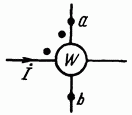

A fixed coil made of rather thick wire has very little active resistance and is called a series winding. It is connected to the circuit in series, like an ammeter.
On the wiring diagram The wattmeter is depicted as shown in Fig. 3.22. One pair of ends (usually horizontal in the figure) belongs to the series winding, the other pair of ends (vertical in the figure) belongs to the parallel winding. At the ends of the winding clamps of the same name (for example, at the beginning of the windings), it is customary to put dots.
The torque of the wattmeter, and hence its readings, is proportional to the real part of the product of the complex voltage on the parallel winding of the wattmeter and the conjugate complex of the current flowing into the end of the series (current) winding of the wattmeter and equipped with a dot:
The voltage on the parallel winding is taken equal to the potential difference between its end, which has a point (point a), and its end, which does not have a point (point). It is assumed that the current flows into the end of the series winding, which has a dot.
The division price of a wattmeter is determined as the quotient of the product of the rated voltage and the rated current (indicated on the front side of the device) divided by the number of scale divisions.
Example 41. The rated voltage of the wattmeter is 120 V. The rated current is 5 A. The scale has 150 divisions. Determine the division value of the wattmeter.
Solution. The price division of the wattmeter is equal to
For direct circuit power measurement direct current wattmeter is used. A fixed series coil or current coil of a wattmeter is connected in series with the receivers. electrical energy. A movable parallel or voltage coil connected in series with an additional resistance forms a parallel circuit of the wattmeter, which is connected in parallel with the energy receivers.
Angle of rotation of the movable part of the wattmeter:
α = k2IIu = k2U/Ru
where I - series coil current; I and - the current of the parallel coil of the wattmeter.

Rice. 1. Scheme of the device and connections of the wattmeter
Since, as a result of the application of additional resistance, the parallel circuit of the wattmeter has practically constant resistance ru , then α = (k2/Ru)IU = k2IU = k3P
Thus, by the angle of rotation of the moving part of the wattmeter, one can judge the power of the circuit.
The wattmeter scale is uniform. When working with a wattmeter, it must be borne in mind that a change in the direction of the current in one of the coils causes a change in the direction of the torque and the direction of rotation of the moving coil, and since the scale of the wattmeter is usually made one-sided, i.e., the scale divisions are located from zero to the right, then if the the direction of the current in one of the coils, it will be impossible to determine the measured value using a wattmeter.
For these reasons, one should always distinguish between the clamps of the wattmeter. The serial winding terminal connected to the power source is called the generator terminal and is marked on the instruments and diagrams with an asterisk. A branch circuit terminal attached to a wire connected to a series coil is also called a generator terminal and is marked with an asterisk.
Thus, with the correct switching circuit of the wattmeter, the currents in the wattmeter coils are directed from the generator clamps to the non-generator ones. There can be two schemes for switching on the wattmeter (see Fig. 2 and Fig. 3).

Rice. 2. Correct scheme turning on the wattmeter
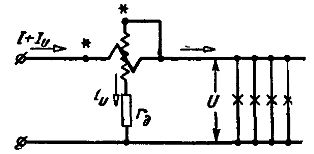
Rice. 3. The correct circuit for switching on the wattmeter
In the diagram given in Fig. 2, the current of the series winding of the wattmeter is equal to the current of the energy receivers whose power is being measured, and the parallel circuit of the wattmeter is energized U "greater than the voltage of the receivers by the amount of voltage drop in the series coil. Therefore, Pv \u003d IU" \u003d I (U + U1 ) = IU = IU1, i.e. the power measured by the wattmeter is equal to the power of the energy receivers to be measured and the power of the series winding of the wattmeter.
In the diagram given in Fig. 3, the voltage on the parallel circuit of the wattmeter is equal to the voltage on the receivers, and the current in the series winding is greater than the current consumed by the receiver by the amount of current in the parallel circuit of the wattmeter. Therefore, P in \u003d U (I + Iu) \u003d UI + UIu, i.e. the power measured by the wattmeter is equal to the power of the energy receivers to be measured and the power of the parallel circuit of the wattmeter.
For measurements in which the power of the wattmeter windings can be neglected, it is preferable to use the circuit shown in Fig. 2, since usually the power of the series winding is less than that of the parallel winding, and therefore the readings of the wattmeter will be more accurate.
For accurate measurements, it is necessary to introduce corrections into the readings of the wattmeter, due to the power of its winding, and in such cases, the circuit in Fig. 3 can be recommended, since the correction is easily calculated using the formula U 2 / Ru, where Ru is usually known, and the correction remains unchanged at different values current if U is constant.
When you turn on the wattmeter according to the circuit in Fig. 2, the potentials of the ends of the coils differ only by the amount of voltage drop in the moving coil, since the generator terminals of the coils are connected together. The voltage drop in the moving coil is negligible compared to the voltage across the parallel circuit, since the resistance of this coil is negligible compared to the resistance of the parallel circuit.

Rice. 4. Incorrect wattmeter switching circuit
On fig. 4 shows an incorrect circuit for connecting a parallel circuit of a wattmeter. Here, the generator terminals of the coils are connected through an additional resistance, as a result of which the potential difference between the ends of the coils is equal to the circuit voltage (sometimes very significant 240 - 600 V), and since the fixed and moving coils are in close proximity to one another, conditions favorable for coil insulation breakdown. In addition, electrostatic interaction will be observed between coils having very different potentials, which can cause additional error when measuring power in an electrical circuit.
If the load current is greater admissible current wattmeter, then the current coil of the wattmeter is switched on through a measuring current transformer (Fig. 1, a).
Rice. 1. Schemes for including a wattmeter in a circuit alternating current with a large current (a) and into a high-voltage network (b).
When choosing a current transformer, it is necessary to ensure that the rated primary current of the transformer I 1i is equal to or greater than the measured current in the network.
For example, if the value of the current in the load reaches 20 A, then you can take a current transformer designed for a primary rated current of 20 A with a rated current transformation ratio Kn1 = I 1i / I 2i = 20/5 = 4.
If, in this case, the voltage in the measuring circuit is less than that allowed by the wattmeter, then the voltage coil is connected directly to the load voltage. The beginning of the voltage coil with a jumper / is connected to the beginning of the current coil. It is also necessary to install jumper 2 (the beginning of the coil is connected to the network). The end of the voltage coil is connected to another network terminal.
To determine the actual power in the measured circuit, it is necessary to multiply the wattmeter reading by the rated transformation ratio of the current transformer: P = Pw x Kn 1 = Pw x 4
If the current in the network can exceed 20 A, then you should choose a current transformer with a primary rated current 50 A, while Kn 1 = 50/5 = 10.
In this case, to determine the power value, the readings of the wattmeter must be multiplied by 10.
From the expression for direct current power P = IU it can be seen that it can be measured using an ammeter and voltmeter by an indirect method. However, in this case, it is necessary to perform simultaneous readings on two instruments and calculations that complicate the measurements and reduce their accuracy.
To measure power in direct and single-phase alternating current circuits, devices called wattmeters are used, for which electrodynamic and ferrodynamic measuring mechanisms are used.
Electrodynamic wattmeters are produced in the form of portable instruments of high accuracy classes (0.1 - 0.5) and are used for accurate measurements of direct and alternating current power at industrial and elevated frequencies (up to 5000 Hz). Ferrodynamic wattmeters are most often found in the form of panel instruments with a relatively low accuracy class (1.5 - 2.5).
Such wattmeters are mainly used on alternating current of industrial frequency. At direct current, they have a significant error due to the hysteresis of the cores.
For power measurement on high frequencies thermoelectric and electronic wattmeters are used, which are a magnetoelectric measuring mechanism equipped with an active power-to-dc converter. In the power converter, the multiplication operation ui = p is carried out and the output signal is obtained, depending on the product ui, i.e., on the power.
On fig. 2a shows the possibility of using an electrodynamic measuring mechanism to build a wattmeter and measure power.
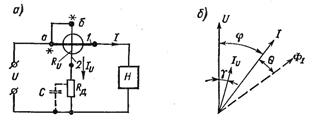
Rice. 2. Scheme of switching on the wattmeter (a) and vector diagram (b)
The fixed coil 1, connected in series to the load circuit, is called the serial circuit of the wattmeter, the moving coil 2 (with an additional resistor), connected in parallel to the load, is called a parallel circuit.
For a DC wattmeter:
![]()
Consider the operation of an electrodynamic wattmeter on alternating current. Vector diagram fig. 2b is built for inductive character loads. The current vector Iu of the parallel circuit lags behind the vector U by an angle γ due to some inductance of the moving coil.
It follows from this expression that the wattmeter correctly measures power only in two cases: at γ = 0 and γ = φ.
The condition γ = 0 can be achieved by creating a voltage resonance in a parallel circuit, for example, by turning on a capacitor C of an appropriate capacitance, as shown by the dashed line in Fig. 1, a. However, the voltage resonance will be only at a certain specific frequency. As the frequency changes, the condition γ = 0 is violated. When γ is not equal to 0, the wattmeter measures power with an error βy, which is called the angular error.
With a small value of the angle γ (γ is usually no more than 40 - 50 "), the relative error
At angles φ close to 90°, the angular error can reach large values.
The second, specific, error of wattmeters is the error due to the power consumption of its coils.
When measuring the power consumed by the load, two schemes for switching on the wattmeter are possible, differing in the inclusion of its parallel circuit (Fig. 3).
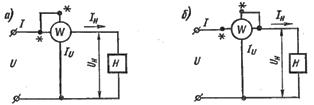
Rice. 3. Schemes for switching on a parallel winding of a wattmeter
If we do not take into account the phase shifts between currents and voltages in the coils and consider the load H as purely active, the errors β(a) and β(b), due to the power consumption of the wattmeter coils, for the circuits of Fig. 3, a and b:

where Pi and Pu are, respectively, the power consumed by the series and parallel circuits of the wattmeter.
It can be seen from the formulas for β(a) and β(b) that errors can have noticeable values only when measuring power in low-power circuits, i.e. when Pi and Pu are commensurate with Рn.
If you change the sign of only one of the currents, then the direction of deviation of the moving part of the wattmeter will change.
The wattmeter has two pairs of clamps (serial and parallel circuits), and depending on their inclusion in the circuit, the direction of deviation of the pointer may be different. To correctly turn on the wattmeter, one of each pair of clamps is marked with an "*" (asterisk) and is called the "generator clamp".
Test questions:
1. What energy does the wattmeter of an electrodynamic system measure?
2. Does the load value affect the wattmeter switching circuit?
3. How to expand the measurement limits of the wattmeter on alternating current?
4. How to determine the power in the DC circuit by measuring the current and voltage?
5. How to turn on the wattmeter correctly single-phase current when measuring power in a controlled circuit?
6. How to measure the apparent power of a single-phase current using an ammeter and a voltmeter?
7. How to determine the reactive power of the circuit?
One of the properties that characterizes the state of an electrical circuit is power. This property reflects the value of work done by electric current for certain time. The power of the equipment included in the electrical circuit should not exceed the power of the network. Otherwise, the equipment may fail, short circuit or fire may occur.
Power measurements electric current produced by special devices - wattmeters. In the case of direct current, the power is calculated by multiplying the voltage by the current (you need an ammeter and a voltmeter). In an alternating current circuit, everything happens differently, you will need measuring instruments. A wattmeter is used to measure the operating mode of electrical equipment, to record electricity consumption.
Scope of use
The main area of use of wattmeters is the industries in the electric power industry, mechanical engineering, and the repair of electrical devices. Wattmeters are also often used in everyday life. They are bought by specialists in electronics, computer equipment, radio amateurs - to calculate the savings in electrical energy consumption.
Wattmeters are used for:
Device power calculations.
Conducting tests electrical circuits, some of their sections.
Carrying out tests of electrical installations, as indicators.
Checking the operation of electrical equipment.
Accounting for electricity consumption.
Varieties
First, voltage is measured, then current, and then power is measured based on these data. According to the method of measuring, converting parameters and issuing the result, wattmeters are divided into digital and analog types.
Digital wattmeters measure. The screen also displays voltage, current, electricity consumption over a period of time. Measurement parameters are displayed on the computer.
analog the wattmeter version is divided into self-recording and indicating devices. They determine the active power of the circuit section. The wattmeter screen is equipped with a scale and an arrow. The scale is calibrated for divisions and power values, in watts.
Design features and principle of operation
Analog types of wattmeters are widespread, accurate measurement, and are devices of the electrodynamic system.
The principle of their operation is based on the interaction between two coils. One coil is fixed, with a thick winding wire, a small number of turns and little resistance. It is connected in series with the consumer. The second coil is moving. Its winding consists of a thin conductor having a significant number of turns, its resistance is high. It is connected in parallel with the consumer, equipped with additional resistance to avoid short circuit windings.
When the device is connected to the network, in the windings there are magnetic fields, the interaction of which forms a moment of rotation that deflects the moving winding with an attached arrow to the calculated angle. The value of the angle depends on the product of voltage and current at a particular moment in time.
The main principle of operation of a digital type wattmeter is the preliminary measurement of voltage and current. For these purposes, they are connected: in a serial circuit to the load consumer - a current sensor, in a parallel circuit, a voltage sensor. These sensors are usually made from thermistors, thermocouples, measuring transformers.
The instantaneous parameters of the measured voltage and current, through the converter, are fed to the internal microprocessor. It calculates power. The result of the information is shown on the screen, and also transmitted to external devices.
Devices of the electrodynamic type, which have wide application, suitable for AC and DC. Inductive type wattmeters are used only for alternating current.
Consider some options for devices (wattmeters) of various versions and various manufacturers.
Household appliances made in China
The manual describes all modes of operation of this device, technical specifications.

In fact, this is a device that measures the power of various electrical consumers. How does he work? Insert it into the socket, and insert the plug of the consumer whose power you want to measure into the socket of this device. With this device you will measure the power of any consumer for a certain time and then with it you can even calculate, for example, how much money your refrigerator or any other device spends on electricity.
The device has a built-in battery. It is needed to remember the power that you measured, and then you will use it to calculate the price. The front panel of the device has five buttons: switching modes, price pointer, up-down switch, reset button if the device has caught any glitch. On the back of the case are the characteristics of the device:
Operating voltage 230 volts.
Frequency 50 hertz.
Maximum current 16 amps.
The range of measured power is 0-3600 watts.
Consider the operation of the device. We insert it into the socket.

Let's turn on the LED table lamp.
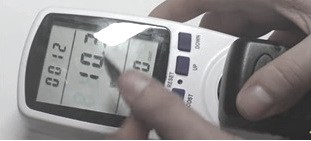
The time immediately started on the display, during which the power of the consumer, in this case the lamp, is measured. 0.4 watts is the power of the switched off lamp. We turn on the lamp, in operating mode it consumes 10.3 watts. We did not indicate the price per kilowatt, so there are zeros there.
Our lamp can change the power of light. As the lamp light increases, the power reading increases. When the second mode is turned on, the operating time is also shown at the top, in the second field, kilowatt hours, since the device has not yet worked even for one hour, zeros are shown. The bottom shows the number of days this consumer was measured.
In the next mode, the second field shows the voltage of the mains, the bottom shows the frequency of the current. The time is shown at the top of the display in all modes. When switching to the next mode, the current strength is shown in the center. At the bottom, a parameter of a certain factor is shown, about which there is no data yet, since the manufacturer of the device is Chinese.
The fifth mode shows the minimum power. In the sixth mode - maximum power.
It will be interesting to see the readings of these modes when the computer is running. For example, in sleep mode, with a normal open desktop, or when launching a powerful game.
In the following mode, set the cost of electricity with the setting buttons, to calculate the cost of energy consumption. So you can measure and calculate the consumption of any of your household appliances and devices, and you will know which devices you have are economical and which consume too much electricity.
Such a device has a low cost, about 14 dollars. This is a small price to pay to optimize your costs by calculating the power consumption of your devices.
Multifunctional digital wattmeter SM 3010

The device is used to measure voltage, frequency, power, direct and alternating current with one phase. And also, it is designed to control such devices with less accuracy.
The current measurement range is 0.002 - 10 amperes.
Voltage measurements:
Constant from 1 to 1000 volts.
Variable from 1 to 700 volts.
The frequency is measured in the range of 40-5000 hertz.
Measurement error
Current, voltage, DC power +
0,1%.
Current, voltage, AC power +
0.1% in the frequency range 40-1500 hertz.
Relative frequency measurement error in the range of 40-5000 hertz +
0,003%.
Dimensions of the body of the device 225 x 100 x 205 mm. Weight 1 kg. Power consumption less than 5 watts.
CPU measuring device 8506 – 120
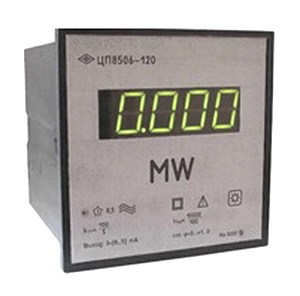
Serves to measure the power of an active and reactive 3-phase AC network, shows the current value of the power parameter on the indicator, converts it into an analog signal.
The measurements taken are shown in the form of numbers on the indicators in units of values that enter the device, or the input of the current or voltage transformer. In this case, the transformation coefficient is taken into account. The digital display is divided into four digits.
Purpose of the device - for measuring active and reactive power in 3-phase electric current networks with a frequency of 50 hertz.
Technical details
Power factor - 1.
Case dimensions 120 x 120 x 150 mm.
The height of the digits on the display is 20 mm.
The largest reading interval is 9999.
Degree of accuracy: 0.5.
Conversion time: less than 0.5 s.
Working temperature: from +5 to + 40 degrees.
Enclosure and panel protection class: IP 40.
Power consumption: 5 watts.
Weight less than 1.2 kg.
The presence of two coils in an electrodynamic device and the possibility of including them in two different circuits makes it possible to use these devices to measure the power of an electric current, i.e., as wattmeters.
From the expression for the angle of rotation of the moving system of the electrodynamic device (2.12), it follows that if the fixed coil is connected in series with the load z (Fig. 2-12), and the additional resistance Yad is connected in series with the moving coil so that this coil can be connected in parallel with the load , then the current in the moving coil is
![]()
where is the resistance of the coil; U - voltage on the load; - the constant of this device in terms of power; P is the power consumed by the load. Such a device is called a wattmeter. His scale is uniform.
For measuring electrical power in AC circuits, active and reactive power wattmeters are used.
Active power wattmeter. If an active additional resistance is included in the moving coil circuit so that the total resistance of this circuit R is equal to
then at voltage and in the network and at current i in the load
![]()
the current in the moving coil is
![]()
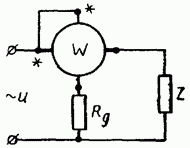

The instantaneous value of the torque in this case is equal to
![]()
and the average value of this moment for the period

Therefore, a wattmeter with an active additional resistance in the moving coil circuit measures the active power of the AC circuit.
The resulting conclusion has a simple physical explanation. Indeed, if an ammeter, voltmeter and wattmeter are included in the circuit with inductance (Fig. 2-13), then, since the moving system of the voltmeter turns under the action of only the applied voltage, regardless of the phase of this voltage (more precisely, under the influence of current in the coil proportional to the applied voltage), and the moving part of the ammeter turns under the influence of only the current in the coil, regardless of the phase of this current. As for the movable part (coil) of the wattmeter, it turns only if the currents in both coils are not equal to zero, otherwise there will be no interaction. But in the circuit under consideration, the current of the moving coil is maximum when the current in circuit i is zero, and vice versa. The device will show nothing. This was to be expected, since the load either stores energy in the magnetic field, or returns it to the network.
From the graph of the currents of this circuit with inductance (Fig. 2-14) it follows that the currents coincide in direction (on the graph - on one side of the time axis) only during two (through one) quarters of the period for the period, and in the other two quarters period, the currents are in opposite directions. This means that the direction of the torque changes four times per period. Therefore, the moving system of the wattmeter during the period will experience the action of four impulses of the same value, but opposite in direction, and the device will not show anything, since the torque acting on the moving system is determined by its average value over the period.
If the shift angle between the currents is small (Fig. 2-15), then during the period the positive values of the torque greatly exceed the negative ones (in time and in values) and the moving system of the wattmeter will turn under the action of the average


values in response to the active power consumed by the given load.
So, the wattmeter shows the active power consumed from the network.
Reactive power wattmeter. In this wattmeter, in series with the moving coil, an inductive additional resistance is specially switched on (Fig. 2-16) such that
Let the applied voltage act in the circuit and the load creates a current
Then the instantaneous value of the torque is
![]()
![]()

After substitution and transformations, we get:
The average value of the torque for the period is

From this it follows that the wattmeter with inductive reactance in the moving coil circuit shows the reactive power of the AC circuit. This conclusion can be easily explained: in the case, for example, of purely inductive load when energy is not irretrievably consumed from the network, such a circuit artificially shifts the phase of the current in the moving coil to coincide with the phase of the current in the stationary one, so the wattmeter shows the value of reactive power.
So, an electrodynamic wattmeter has two coils: one is a current coil connected in series with the load, the other is a voltage coil connected in parallel with the load, the power consumption of which must be measured.
To turn on the device correctly (so that the arrow deviates in the right direction), one of the terminals of its winding is marked with an asterisk; these terminals of the wattmeter are called generator terminals. They should be connected to the load terminal that is connected to the generator (mains).





